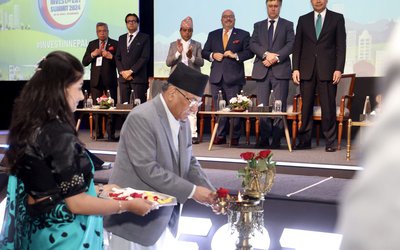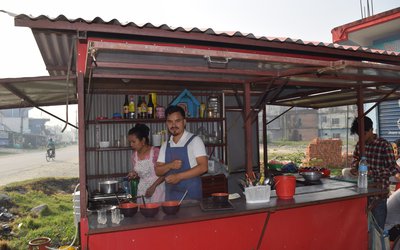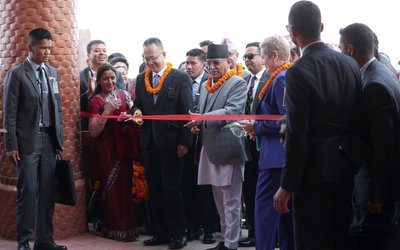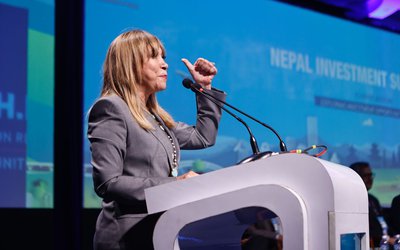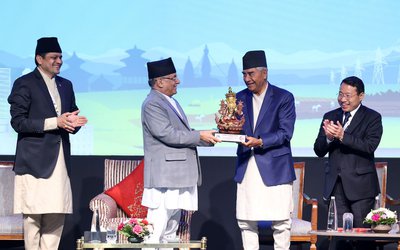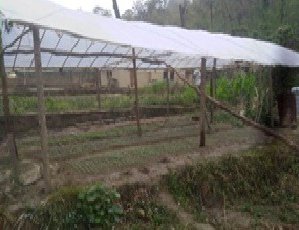
Designed in 2011 as an adaptation flagship program to implement the most urgent and immediate adaptation needs as prioritized in the National Adaptation Program of Action (NAPA, 2010), Nepal Climate Change Support Program(NCCSP) - a government-led program - has maintained its 'flagship identity' at its second phase as well. NCCSP2 is implemented in 42 municipalities of three provinces (Lumbini, Karnali and Sudur Paschhim Provinces) by preparing and implementing the Local Adaptation Plan for Actions (LAPAs). The Program contributes to adapt to the adverse effects of climate change and build resilience of the climate vulnerable communities of the target municipalities. Further recognizing the climate vulnerabilities, climate change adaptation (CCA) actions are being implemented in 34 municipalities in the Karnali Province. MoFE is implementing it with the financial support from the Foreign, Commonwealth & Development Office (FCDO) and the British Embassy in Nepal and technical assistance of the Mott MacDonald.
NCCSP2 has multi-pronged approaches in supporting the municipalities. As planned, it provides technical and financial supports to implement CCA interventions to help climate vulnerable communities build adaptive capacity and assist in making the infrastructures climate-resilient. It contributes to building capacity to mainstream CCA into planning processes and programs of the municipalities. It empowers local levels to manage public finance such as in preparing budgets, train municipal officials on best practices on public finance management, fiduciary risk management and procurement processes and to ensure transparency and accountability. Most importantly, NCCSP has linked its people-prioritized adaptation actions with income generation and livelihoods improvement.
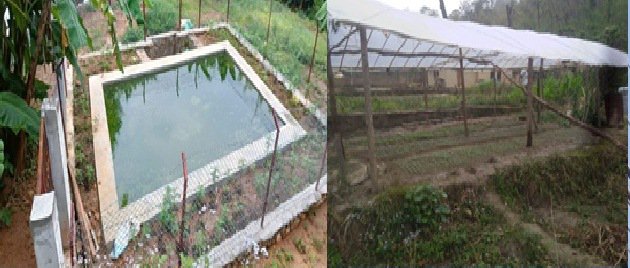
Caption: NCCSP supported Irrigation Pond in Narayan Municipality, Dailekh , Agriculture activities in Bheri Ganga Municipality, Surkhet Photo: Naresh Sharma, NPM
Using the LAPA framework, NCCSP2 has supported to implement prioritized adaptation interventions in thematic and sub-thematic areas such as irrigation, drinking water, flood control and other water uses, including CCA actions to stabilize slopes and control landslides, improve roads, increase agriculture productivity, and increase forest productivity. Municipalities are expected to internalize and institutionalize CCA interventions to reduce dependencies on projects.
Several projects have supported to prepare LAPAs; a concept emerged in May 2009 to localize adaptation interventions. This resulted to the issuance of the National Framework on LAPA in 2011 which was re-issued in 2019 taking note of 7 years of experience in raising awareness, and building human resource to prepare, and implement LAPAs, including mainstreaming CCA into national to local planning and programming processes. Importance of LAPAs has been greatly realized in addressing climate change impacts in Nepal.
Five years back, Adaptation for Smallholders in Hilly Areas (ASHA) Project, executed by the then Ministry of Forests and Soil Conservation with support from the International Fund for Agricultural Development (IFAD) to improve the livelihood and resilience of smallholders in hilly areas of seven districts of Lumbini and Karnali Provinces, published an enhanced LAPA Manual in January 2018. It aims to make familiar on eLAPA preparation, help stakeholders to provide insights on integration of scientific information for eLAPA preparation, and support to identify and prioritize adaptation options based on climate trends. eLAPA manual considers sub-watershed a LAPA unit, and promotes GIS application, participatory scenario development, harmonizes scientific information with local perceptions and follows the LAPA Framework 2011 in preparing LAPAs. The 2011 LAPA Framework opens avenues to use science to formulate LAPAs and encourages LAPA formulating and implementing entities to select the unit (of LAPA) which may be municipality, ward, settlement, micro-watershed, and sub-watershed, political or administrative boundaries as appropriate. Tendency of adding or removing few elements and branding for project is a common practice in Nepal. Weak regulatory effort has made possible to brand as project outcomes which looks simply the 'same wine in the new bottle'.
In LAPA programs, the government has shown remarkable 'leadership' in administering the demand-based adaptation activities at the local level. Government 'ownership' on the flagship adaptation program and on its outputs and outcomes has developed 'confidence' that adaptation interventions work well with people's participation and help to address the threats of climate change. Furthermore, strong 'dedication and commitment' of the Program Director and the Manager, including the NCCSP2 officials in supporting the climate vulnerable communities to identify, prioritize and implement adaptation prescriptions in climate vulnerable areas informs climate communities to scale-up and scale-out good practices and negotiate with partners for additional and predictable resources for CCA interventions country-wide. Nepal should promote sharing of decade-long knowledge and learning on adaptation planning and implementation at the grass-root level through the 'flagship' programs, including NAPA and National Adaptation Plan (NAP) formulation processes to timely inform the international communities to consider additional actions and provide financial resources & technologies to protect climate vulnerable mountain communities, their livelihoods, and natural resources from climate-induced disasters.
Adaptation needs are well recognized in Second Nationally Determined Contribution (NDC2). It targets to prepare and implement climate-resilient and gender-responsive adaptation plans (LAPAs) in all 753 local governments by 2030. As per the national needs, and international commitments on targets, local governments should prepare and implement gender-responsive LAPAs. To facilitate it, the government has issued GESI Strategy and Action Plan (SAP) on Climate Change (2020-2030) in December 2020. The GESI SAP has objectives, inter alia, of: (i) mainstreaming GESI and gender empowerment into climate change related policies and plans at three-tiers of government; and (ii) institutionalizing GESI at local level CCA planning and implementation processes. In a nutshell, government commitments of preparing and implementing gender-responsive LAPAs should be institutionalized at all levels to the earliest possible.
As per the call and guidance of the Climate Change Management Division (CCMD) of the Ministry of Forests and Environment, the Global Water Partnership (GWP)/Jalsrot Vikas Sanstha (JVS) under the NDC Partnership Support Program has supported the preparation of the gender-responsive LAPAs in Kali Gandaki and Chhatrakot Rural Municipalities, Gulmi. These two municipality-level LAPAs are expected to provide guidance for future LAPAs in the spirit of the NDC2. Organization(s) supporting the preparation and implementation of LAPAs are encouraged to focus on gender-responsive LAPAs as a move to meet the national needs and international commitments in localizing CCA and implement 'gender-responsive flagship adaptation' program to be the leading country in this undertaking as well.

Batu Uprety
Former Joint-Secretary and Chief of Climate Change Management Division, Ministry of Environment (then), and former Team Leader, National Adaptation Plan (NAP) formulation process. E-mail: upretybk@gmail.com
- Dialogue On Mountains And Climate Change Planned
- Apr 19, 2024
- Institutional Response And Leadership on Climate Negotiations
- Mar 28, 2024
- The Wire Without A Current
- Mar 20, 2024
- Call For Degazetting the Shivapuri-Nagarjun National Park
- Feb 08, 2024
- Advancing Need-Based Adaptation Options
- Jan 14, 2024

